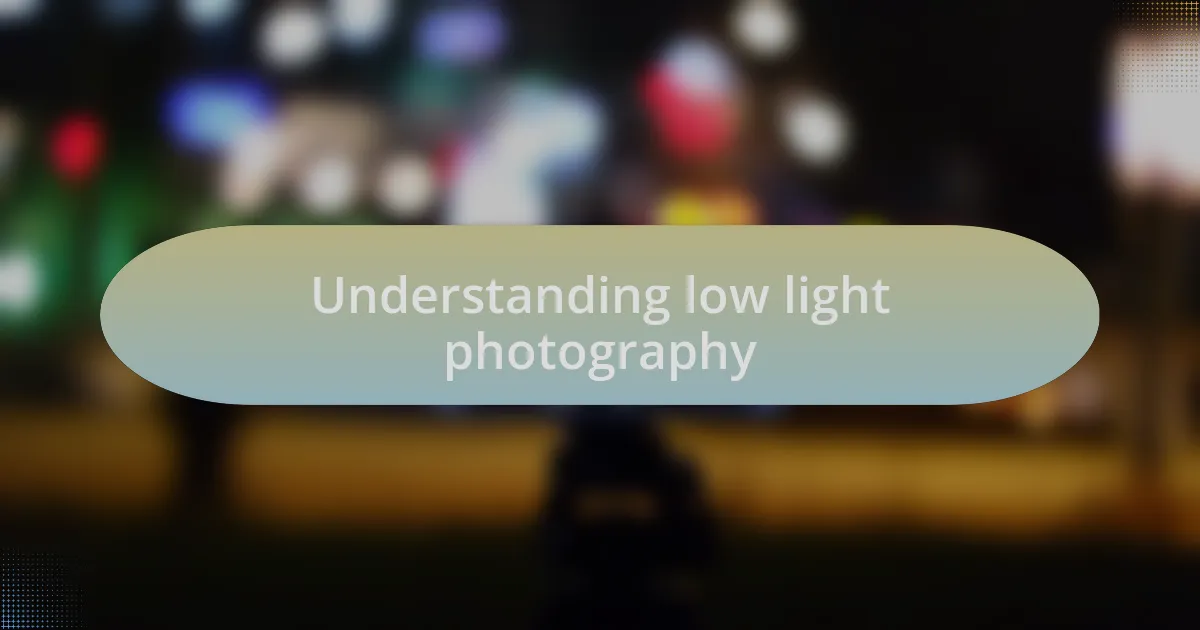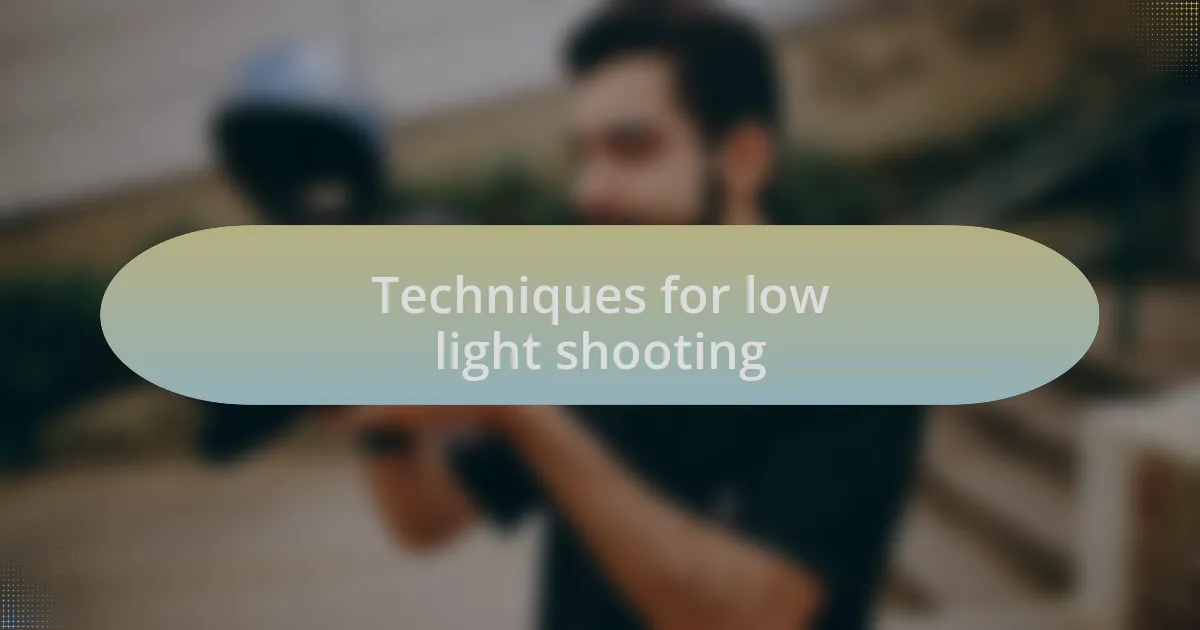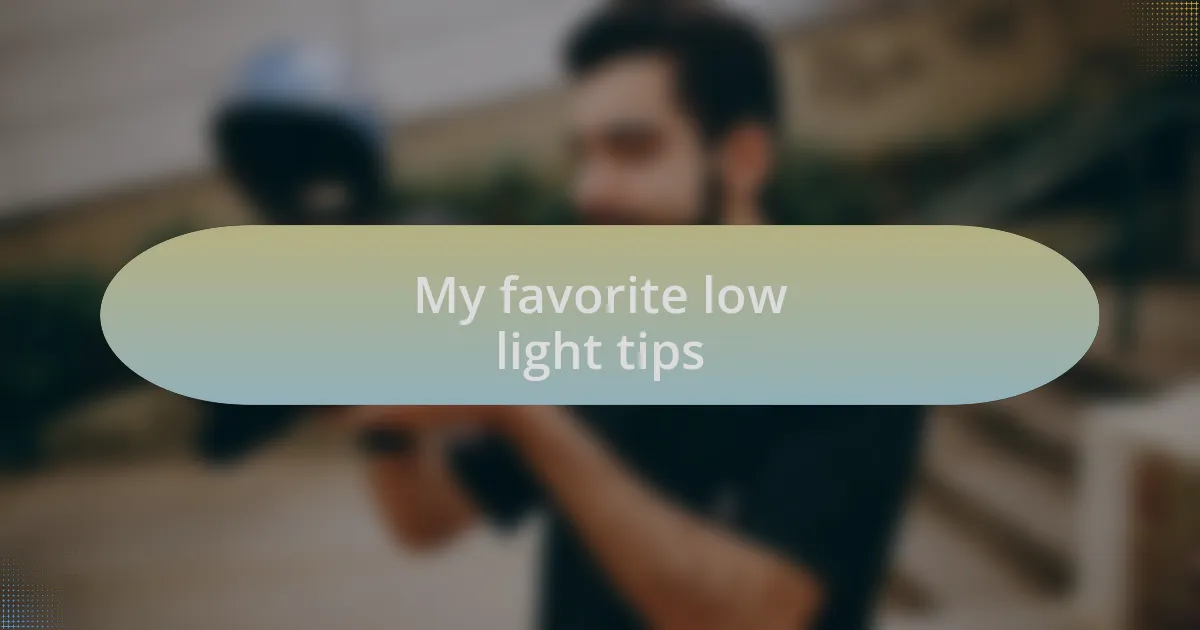Key takeaways:
- Low light photography offers unique opportunities for creativity, transforming mundane scenes into captivating images.
- Utilizing a wide aperture and stabilization techniques, such as using a tripod, enhances image quality in low light conditions.
- Embracing higher ISO settings and manual focus can lead to unexpected artistic outcomes, revealing new perspectives.
- A flashlight can be a valuable tool for framing shots and illuminating details that may otherwise be overlooked in dim environments.

Understanding low light photography
Low light photography is often seen as a challenge, but I find beauty in this struggle. The soft, diffused light creates a unique atmosphere that can transform a mundane scene into something magical. Have you ever captured a glowing street lamp against a dark sky? That contrast is what I cherish most.
When I first started shooting in low light, I felt overwhelmed by the limitations of my camera, battling with noise and motion blur. However, through experimentation, I discovered the importance of adjusting my settings meticulously. Increasing the ISO felt like unlocking a new level, allowing me to capture details that would otherwise fade into darkness.
I’ve often found myself in enchanting settings where the light was dim, yet the potential for remarkable images was palpable. It struck me that low light isn’t merely a limitation; it’s an invitation to explore creativity. How often do we step outside our comfort zones? For me, diving into low light photography has opened up a world of unexpected discoveries, fueling my passion for capturing the unseen.

Techniques for low light shooting
One technique that has always helped me in low light situations is utilizing a wide aperture. Opening up my lens to f/1.8 or even f/1.4 allows more light to hit the sensor, creating beautiful bokeh and isolating my subject from the background. I remember one evening at a dimly lit café, where the chatter and clinking of cups created an ambient backdrop; my wide aperture captured those moments with such depth that I could almost hear the conversations in the photographs.
Stabilization is another critical component for successfully shooting in low light. I’ve learned the hard way that even the slightest shake can ruin a shot. Using a tripod or resting the camera on a solid surface has been invaluable. I recall one particularly haunting night when I set my camera on an old stone wall, capturing the melancholy glow of a full moon filtering through the branches. That stillness transformed my image, emphasizing the tranquility of the moment.
Finally, playing with long exposure can yield stunning results in low light. When I deliberately varied my shutter speed, I was amazed at how the world changed on the sensor. I once captured a bustling street scene with moving cars that turned into ethereal light trails, making the chaos look dreamlike. How fascinating it is that a simple adjustment can deliver such contrasting emotions in our images—what are your thoughts on this technique?

My favorite low light tips
One of my favorite tips for low light photography is to embrace higher ISO settings. I often push my camera to ISO 1600 or beyond, even though it tends to introduce some noise. But I remember an extraordinary night at a street festival; the vivid colors of the lights shone through the grain, adding a gritty yet vibrant feel to my images that I truly loved. Isn’t it fascinating how sometimes embracing imperfections can lead to unexpected artistic expressions?
Using manual focus has also become a game-changer for me in low light situations. Autofocus struggles in dim environments, often hunting for clarity but coming up short. I recall standing beneath a softly lit bridge one evening, manually adjusting my focus until the soft reflections in the water came into sharp view. That moment taught me to trust my instincts—have you ever found focus to be a more intuitive process when you take control?
Lastly, I always keep a flashlight handy to help with framing my shots. It’s surprising how a little bit of light can reveal details that your eye might miss in the darkness. One evening while shooting an abandoned building, I used my flashlight to illuminate the intricate details of the peeling paint and rusted metal, creating a stark yet beautiful contrast. Isn’t it amazing how a simple tool can transform your perspective and elevate your storytelling?